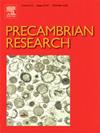Spatiotemporal fluctuations of pyrite sulfur isotope with pyrite morphology during the Ediacaran-Cambrian transition
IF 3.2
2区 地球科学
Q2 GEOSCIENCES, MULTIDISCIPLINARY
引用次数: 0
Abstract
The rapid fluctuations in the bulk-sample sulfur isotope of sedimentary pyrite (δ34Spy) serve as a crucial indicator of marine redox changes during the Ediacaran-Cambrian transition (E-C). However, these bulk δ34Spy values are susceptible to diagenetic alterations, which can alter the ratio of euhedral to framboidal crystals, thereby inducing fluctuations in δ34Spy values. To assess the impact of diagenesis on δ34Spy variability across the E-C transition, we conducted a comprehensive analysis of spatiotemporal variations in δ34Spy across five E-C sections in South China, encompassing diverse environmental settings. Additionally, we characterized pyrite morphologies, distinguishing between framboidal and non-framboidal forms. The results demonstrate a consistent decrease in δ34Spy values with increasing water depth, accompanied by an increase in the proportion of framboids. Specifically, in shallow water platform settings, the mean δ34Spy value is + 34.0 ‰, with a mean framboid proportion of 6 %. Conversely, in the deep water basin environment, the mean δ34Spy value drops to + 5.6 ‰, with a mean framboid proportion of 45 %. A positive δ34Spy excursion, ranging from + 5.1 ‰ to + 51.0 ‰, is observed in the platform at the base of the E-C transition, while a negative excursion, spanning from + 13.0 ‰ to −28.2 ‰ (and from + 14.9 ‰ to −19.5 ‰ in another section), is evident in the basin. Crucially, a consistent negative correlation is observed between framboid proportions and bulk δ34Spy values. This relationship underscores the significance of both the timing of pyrite formation and its local redox condition. Our findings reveal that marine oxidation occurred in uneven pulses during the E-C transition. Furthermore, we emphasize the necessity of considering pyrite morphologies when interpreting δ34Spy records, as framboids may offer a more reliable signal of seawater conditions. Overall, this study provides new insights into the complex interplay between diagenetic alterations, pyrite morphology, and marine redox variations during the E-C transition, underscoring the dynamic nature of marine oxidation during this critical period in Earth’s history.
求助全文
约1分钟内获得全文
求助全文
来源期刊

Precambrian Research
地学-地球科学综合
CiteScore
7.20
自引率
28.90%
发文量
325
审稿时长
12 months
期刊介绍:
Precambrian Research publishes studies on all aspects of the early stages of the composition, structure and evolution of the Earth and its planetary neighbours. With a focus on process-oriented and comparative studies, it covers, but is not restricted to, subjects such as:
(1) Chemical, biological, biochemical and cosmochemical evolution; the origin of life; the evolution of the oceans and atmosphere; the early fossil record; palaeobiology;
(2) Geochronology and isotope and elemental geochemistry;
(3) Precambrian mineral deposits;
(4) Geophysical aspects of the early Earth and Precambrian terrains;
(5) Nature, formation and evolution of the Precambrian lithosphere and mantle including magmatic, depositional, metamorphic and tectonic processes.
In addition, the editors particularly welcome integrated process-oriented studies that involve a combination of the above fields and comparative studies that demonstrate the effect of Precambrian evolution on Phanerozoic earth system processes.
Regional and localised studies of Precambrian phenomena are considered appropriate only when the detail and quality allow illustration of a wider process, or when significant gaps in basic knowledge of a particular area can be filled.
 求助内容:
求助内容: 应助结果提醒方式:
应助结果提醒方式:


